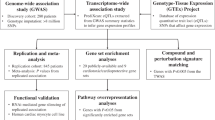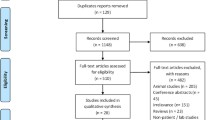Abstract
Purpose
Anthracyclines are widely used chemotherapeutic drugs that can cause progressive and irreversible cardiac damage and fatal heart failure. Several genetic variants associated with anthracycline-induced cardiotoxicity (AIC) have been identified, but they explain only a small proportion of the interindividual differences in AIC susceptibility.
Methods
In this study, we evaluated the association of low-frequency variants with risk of chronic AIC using the Illumina HumanExome BeadChip array in a discovery cohort of 61 anthracycline-treated breast cancer patients with replication in a second independent cohort of 83 anthracycline-treated pediatric cancer patients, using gene-based tests (SKAT-O).
Results
The most significant associated gene in the discovery cohort was ETFB (electron transfer flavoprotein beta subunit) involved in mitochondrial β-oxidation and ATP production (P = 4.16 × 10−4) and this association was replicated in an independent set of anthracycline-treated cancer patients (P = 2.81 × 10−3). Within ETFB, we found that the missense variant rs79338777 (p.Pro52Leu; c.155C > T) made the greatest contribution to the observed gene association and it was associated with increased risk of chronic AIC in the two cohorts separately and when combined (OR 9.00, P = 1.95 × 10−4, 95% CI 2.83–28.6).
Conclusions
We identified and replicated a novel gene, ETFB, strongly associated with chronic AIC independently of age at tumor onset and related to anthracycline-mediated mitochondrial dysfunction. Although experimental verification and further studies in larger patient cohorts are required to confirm our finding, we demonstrated that exome array data analysis represents a valuable strategy to identify novel genes contributing to the susceptibility to chronic AIC.

Similar content being viewed by others
References
Barry E, Alvarez JA, Scully RE et al (2007) Anthracycline-induced cardiotoxicity: course, pathophysiology, prevention and management. Expert Opin Pharmacother 8:1039–1058. doi:10.1517/14656566.8.8.1039
Volkova M, Russell R (2011) Anthracycline cardiotoxicity: prevalence, pathogenesis and treatment. Curr Cardiol Rev 7:214–220
Lipshultz SE, Lipsitz SR, Sallan SE et al (2005) Chronic progressive cardiac dysfunction years after doxorubicin therapy for childhood acute lymphoblastic leukemia. J Clin Oncol 23:2629–2636. doi:10.1200/JCO.2005.12.121
Lipshultz SE, Colan SD, Gelber RD et al (1991) Late cardiac effects of doxorubicin therapy for acute lymphoblastic leukemia in childhood. N Engl J Med 324:808–815. doi:10.1056/NEJM199103213241205
Von Hoff DD, Layard MW, Basa P et al (1979) Risk factors for doxorubicin-induced congestive heart failure. Ann Intern Med 91:710–717
Wojnowski L, Kulle B, Schirmer M et al (2005) NAD(P)H oxidase and multidrug resistance protein genetic polymorphisms are associated with doxorubicin-induced cardiotoxicity. Circulation 112:3754–3762. doi:10.1161/CIRCULATIONAHA.105.576850
Blanco JG, Leisenring WM, Gonzalez-Covarrubias VM et al (2008) Genetic polymorphisms in the carbonyl reductase 3 gene CBR3 and the NAD(P)H:quinone oxidoreductase 1 gene NQO1 in patients who developed anthracycline-related congestive heart failure after childhood cancer. Cancer 112:2789–2795. doi:10.1002/cncr.23534
Rajić V, Aplenc R, Debeljak M et al (2009) Influence of the polymorphism in candidate genes on late cardiac damage in patients treated due to acute leukemia in childhood. Leuk Lymphoma 50:1693–1698
Rossi D, Rasi S, Franceschetti S et al (2009) Analysis of the host pharmacogenetic background for prediction of outcome and toxicity in diffuse large B-cell lymphoma treated with R-CHOP21. Leukemia 23:1118–1126. doi:10.1038/leu.2008.398
Blanco JG, Sun C-L, Landier W et al (2012) Anthracycline-related cardiomyopathy after childhood cancer: role of polymorphisms in carbonyl reductase genes–a report from the Children’s Oncology Group. J Clin Oncol 30:1415–1421. doi:10.1200/JCO.2011.34.8987
Semsei AF, Erdelyi DJ, Ungvari I et al (2012) ABCC1 polymorphisms in anthracycline-induced cardiotoxicity in childhood acute lymphoblastic leukaemia. Cell Biol Int 36:79–86. doi:10.1042/CBI20110264
Cascales A, Sánchez-Vega B, Navarro N et al (2012) Clinical and genetic determinants of anthracycline-induced cardiac iron accumulation. Int J Cardiol 154:282–286. doi:10.1016/j.ijcard.2010.09.046
Visscher H, Ross CJD, Rassekh SR et al (2012) Pharmacogenomic prediction of anthracycline-induced cardiotoxicity in children. J Clin Oncol 30:1422–1428. doi:10.1200/JCO.2010.34.3467
Volkan-Salanci B, Aksoy H, Kiratli PÖ et al (2012) The relationship between changes in functional cardiac parameters following anthracycline therapy and carbonyl reductase 3 and glutathione S transferase Pi polymorphisms. J Chemother 24:285–291. doi:10.1179/1973947812Y.0000000037
Armenian SH, Ding Y, Mills G et al (2013) Genetic susceptibility to anthracycline-related congestive heart failure in survivors of haematopoietic cell transplantation. Br J Haematol 163:205–213. doi:10.1111/bjh.12516
Lipshultz SE, Lipsitz SR, Kutok JL et al (2013) Impact of hemochromatosis gene mutations on cardiac status in doxorubicin-treated survivors of childhood high-risk leukemia. Cancer 119:3555–3562. doi:10.1002/cncr.28256
Lubieniecka JM, Graham J, Heffner D et al (2013) A discovery study of daunorubicin induced cardiotoxicity in a sample of acute myeloid leukemia patients prioritizes P450 oxidoreductase polymorphisms as a potential risk factor. Front Genet 4:231. doi:10.3389/fgene.2013.00231
Cascales A, Pastor-Quirante F, Sánchez-Vega B et al (2013) Association of anthracycline-related cardiac histological lesions with NADPH oxidase functional polymorphisms. Oncologist 18:446–453. doi:10.1634/theoncologist.2012-0239
Visscher H, Ross CJD, Rassekh SR et al (2013) Validation of variants in SLC28A3 and UGT1A6 as genetic markers predictive of anthracycline-induced cardiotoxicity in children. Pediatr Blood Cancer 60:1375–1381. doi:10.1002/pbc.24505
Vivenza D, Feola M, Garrone O et al (2013) Role of the renin-angiotensin-aldosterone system and the glutathione S-transferase Mu, Pi and Theta gene polymorphisms in cardiotoxicity after anthracycline chemotherapy for breast carcinoma. Int J Biol Markers 28:e336–e347. doi:10.5301/jbm.5000041
Wang X, Liu W, Sun C-L et al (2014) Hyaluronan synthase 3 variant and anthracycline-related cardiomyopathy: a report from the children’s oncology group. J Clin Oncol 32:647–653. doi:10.1200/JCO.2013.50.3557
Aminkeng F, Bhavsar AP, Visscher H et al (2015) A coding variant in RARG confers susceptibility to anthracycline-induced cardiotoxicity in childhood cancer. Nat Genet 47:1079–1084. doi:10.1038/ng.3374
Krajinovic M, Elbared J, Drouin S et al (2015) Polymorphisms of ABCC5 and NOS3 genes influence doxorubicin cardiotoxicity in survivors of childhood acute lymphoblastic leukemia. Pharmacogenomics J. doi:10.1038/tpj.2015.63
Visscher H, Rassekh SR, Sandor GS et al (2015) Genetic variants in SLC22A17 and SLC22A7 are associated with anthracycline-induced cardiotoxicity in children. Pharmacogenomics 16:1065–1076. doi:10.2217/pgs.15.61
Vulsteke C, Pfeil AM, Maggen C et al (2015) Clinical and genetic risk factors for epirubicin-induced cardiac toxicity in early breast cancer patients. Breast Cancer Res Treat 152:67–76. doi:10.1007/s10549-015-3437-9
Hertz DL, Caram MV, Kidwell KM et al (2016) Evidence for association of SNPs in ABCB1 and CBR3, but not RAC2, NCF4, SLC28A3 or TOP2B, with chronic cardiotoxicity in a cohort of breast cancer patients treated with anthracyclines. Pharmacogenomics 17:231–240. doi:10.2217/pgs.15.162
Wang X, Sun C-L, Quiñones-Lombraña A et al (2016) CELF4 Variant and anthracycline-related cardiomyopathy: a Children’s Oncology Group Genome-Wide Association Study. J Clin Oncol 34:863–870. doi:10.1200/JCO.2015.63.4550
Leong SL, Chaiyakunapruk N, Lee SWH (2017) Candidate gene association studies of anthracycline-induced cardiotoxicity: a systematic review and meta-analysis. Sci Rep 7:39. doi:10.1038/s41598-017-00075-1
Clinical trial “Genetic Expression and Prediction of Response to Neoadjuvant Docetaxel or Doxorubicin in Locally Advanced Breast Cancer”, identifier code: NCT00123929, https://clinicaltrials.gov
Martin M, Romero A, Cheang MCU et al (2011) Genomic predictors of response to doxorubicin versus docetaxel in primary breast cancer. Breast Cancer Res Treat 128:127–136. doi:10.1007/s10549-011-1461-y
Gonzalez-Neira A, Ruiz-Pinto S, Pita G., Patiño-García A Exome array analysis identifies GPR35 as a novel susceptibility gene for anthracycline-induced cardiotoxicity in childhood cancer
U.S. Department of Health and Human services, National Cancer Institute. Cancer therapy Evaluation program-Common terminology Criteria for Adverse Events (CTCAE)-version 4.0. 2010
Goldstein JI, Crenshaw A, Carey J et al (2012) zCall: a rare variant caller for array-based genotyping: genetics and population analysis. Bioinforma Oxf Engl 28:2543–2545. doi:10.1093/bioinformatics/bts479
Price AL, Patterson NJ, Plenge RM et al (2006) Principal components analysis corrects for stratification in genome-wide association studies. Nat Genet 38:904–909. doi:10.1038/ng1847
Purcell S, Neale B, Todd-Brown K et al (2007) PLINK: a tool set for whole-genome association and population-based linkage analyses. Am J Hum Genet 81:559–575. doi:10.1086/519795
PLINK software: http://pngu.mgh.harvard.edu/~purcell/plink/index.shtml
Lee S, Wu MC, Lin X (2012) Optimal tests for rare variant effects in sequencing association studies. Biostat Oxf Engl 13:762–775. doi:10.1093/biostatistics/kxs014
Lee S, Emond MJ, Bamshad MJ et al (2012) Optimal unified approach for rare-variant association testing with application to small-sample case-control whole-exome sequencing studies. Am J Hum Genet 91:224–237. doi:10.1016/j.ajhg.2012.06.007
Aulchenko YS, Ripke S, Isaacs A, van Duijn CM (2007) GenABEL: an R library for genome-wide association analysis. Bioinforma Oxf Engl 23:1294–1296. doi:10.1093/bioinformatics/btm108
Kumar P, Henikoff S, Ng PC (2009) Predicting the effects of coding non-synonymous variants on protein function using the SIFT algorithm. Nat Protoc 4:1073–1081. doi:10.1038/nprot.2009.86
Adzhubei IA, Schmidt S, Peshkin L et al (2010) A method and server for predicting damaging missense mutations. Nat Methods 7:248–249. doi:10.1038/nmeth0410-248
Li B, Krishnan VG, Mort ME et al (2009) Automated inference of molecular mechanisms of disease from amino acid substitutions. Bioinforma Oxf Engl 25:2744–2750. doi:10.1093/bioinformatics/btp528
Bendl J, Stourac J, Salanda O et al (2014) PredictSNP: robust and accurate consensus classifier for prediction of disease-related mutations. PLoS Comput Biol 10:e1003440. doi:10.1371/journal.pcbi.1003440
Bartlett K, Eaton S (2004) Mitochondrial beta-oxidation. Eur J Biochem 271:462–469
Huyghe JR, Jackson AU, Fogarty MP et al (2013) Exome array analysis identifies new loci and low-frequency variants influencing insulin processing and secretion. Nat Genet 45:197–201. doi:10.1038/ng.2507
Wessel J, Chu AY, Willems SM et al (2015) Low-frequency and rare exome chip variants associate with fasting glucose and type 2 diabetes susceptibility. Nat Commun 6:5897. doi:10.1038/ncomms6897
Richards AL, Leonenko G, Walters JT et al (2016) Exome arrays capture polygenic rare variant contributions to schizophrenia. Hum Mol Genet 25:1001–1007. doi:10.1093/hmg/ddv620
Kozlitina J, Smagris E, Stender S et al (2014) Exome-wide association study identifies a TM6SF2 variant that confers susceptibility to nonalcoholic fatty liver disease. Nat Genet 46:352–356. doi:10.1038/ng.2901
Ishizaki K, Schauer N, Larson TR et al (2006) The mitochondrial electron transfer flavoprotein complex is essential for survival of Arabidopsis in extended darkness. Plant J Cell Mol Biol 47:751–760. doi:10.1111/j.1365-313X.2006.02826.x
Fillmore N, Mori J, Lopaschuk GD (2014) Mitochondrial fatty acid oxidation alterations in heart failure, ischaemic heart disease and diabetic cardiomyopathy. Br J Pharmacol 171:2080–2090. doi:10.1111/bph.12475
Abdel-aleem S, El-Merzabani MM, Sayed-Ahmed M et al (1997) Acute and chronic effects of adriamycin on fatty acid oxidation in isolated cardiac myocytes. J Mol Cell Cardiol 29:789–797. doi:10.1006/jmcc.1996.0323
Tokarska-Schlattner M, Zaugg M, Zuppinger C et al (2006) New insights into doxorubicin-induced cardiotoxicity: the critical role of cellular energetics. J Mol Cell Cardiol 41:389–405. doi:10.1016/j.yjmcc.2006.06.009
Rochette L, Guenancia C, Gudjoncik A et al (2015) Anthracyclines/trastuzumab: new aspects of cardiotoxicity and molecular mechanisms. Trends Pharmacol Sci 36:326–348. doi:10.1016/j.tips.2015.03.005
Kumar SN, Konorev EA, Aggarwal D, Kalyanaraman B (2011) Analysis of proteome changes in doxorubicin-treated adult rat cardiomyocyte. J Proteomics 74:683–697. doi:10.1016/j.jprot.2011.02.013
Chen Y, Daosukho C, Opii WO et al (2006) Redox proteomic identification of oxidized cardiac proteins in adriamycin-treated mice. Free Radic Biol Med 41:1470–1477. doi:10.1016/j.freeradbiomed.2006.08.006
Acknowledgements
This work was supported by the Spanish Association against Cancer (AECC: Asociación Española contra el Cáncer) and from ISCIII project grant (PI12/00226). Human Genotyping lab is a member of CeGen, PRB2-ISCIII and is supported by grant PT13/0001/0005, of the PE I + D+i 2013-2016, funded by ISCIII and ERDF (Fondo Europeo de Desarrollo Regional). Sara Ruiz-Pinto is a predoctoral fellow supported by the Severo Ochoa Excellence Programme (Project SEV-2011-0191).
Author information
Authors and Affiliations
Corresponding author
Ethics declarations
Conflict of interest
The authors indicated no potential conflicts of interest.
Electronic supplementary material
Below is the link to the electronic supplementary material.
Rights and permissions
About this article
Cite this article
Ruiz-Pinto, S., Pita, G., Martín, M. et al. Exome array analysis identifies ETFB as a novel susceptibility gene for anthracycline-induced cardiotoxicity in cancer patients. Breast Cancer Res Treat 167, 249–256 (2018). https://doi.org/10.1007/s10549-017-4497-9
Received:
Accepted:
Published:
Issue Date:
DOI: https://doi.org/10.1007/s10549-017-4497-9




